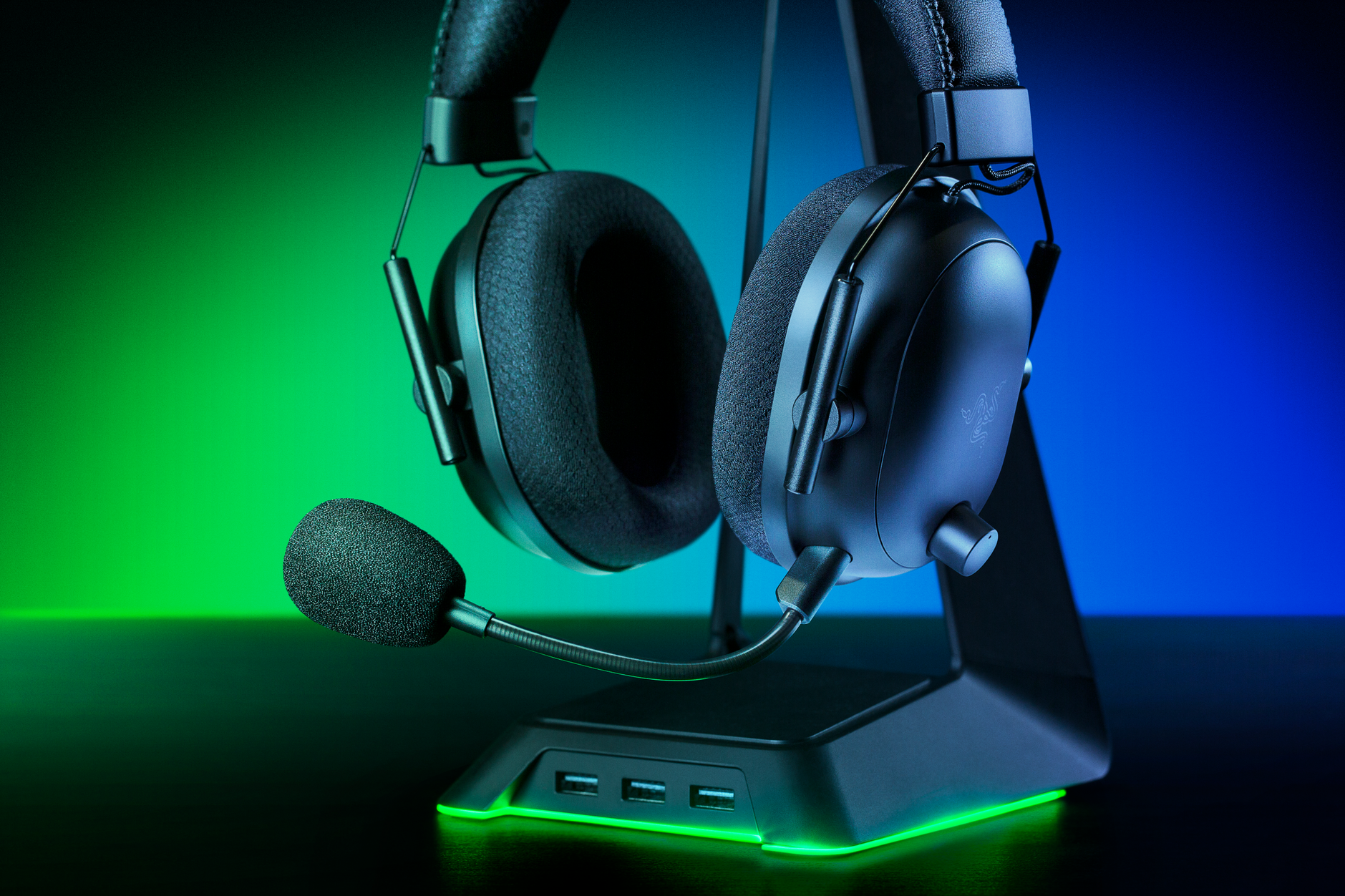Razer’s new wireless mouse, keyboard and headset excel — but they could be more cohesive
Razer's new wireless gear is ambitious, but could work together better

UPDATE, 10/15: This piece initially reported that the Razer BlackWidow V3 Pro and BlackShark V2 Pro offered inconsistent wireless performance. After conferring with Razer, we discovered that these issues were due to a second set of gaming wireless peripherals connected to our test computer. We've updated the piece to reflect the keyboard and headset's better performance.
Razer has become the latest gaming manufacturer to offer a suite of wireless gear, with the release of the DeathAdder V2 Pro mouse, the BlackWidow V3 Pro keyboard and the BlackShark V2 Pro headset. These expensive peripherals can completely declutter your desk, and employ tried-and-true Razer designs. In theory, they’re everything you love about Razer gear, just without wires. In practice, though, it’s a little more complicated than that.
While the Razer wireless flagships are familiar and functional, they also run up against some software issues, and the sense that for the price, some of the products could be a little more consistently designed. Since we’ve already reviewed each gadget’s wired counterpart, here’s a brief impression of each device to discuss its strengths and shortcomings.
- Listen in with the best gaming headsets
- Try the best gaming keyboards
- Plus: Razer Huntsman Tournament Edition Review: Lightweight and Lightspeed
Razer DeathAdder V2 Pro

We’ve written a lot about the DeathAdder over the years. Consistently one of the most popular gaming mice on the market, the DeathAdder combines an ergonomic design with great in-game functionality. The Razer DeathAdder V2 was the best version yet, and the Razer DeathAdder V2 Pro ($130) is simply a wireless version. While the mouse is expensive, it’s not quite as bad as Logitech’s flagship wireless mouse (the $150 Logitech G502 Lightspeed), although it’s a bit disappointing that you have to buy a charging dock separately. (This came bundled with previous wireless Razer mice — although those mice were also more expensive, so take it for what it’s worth.)
Of the three Razer wireless flagship products, the DeathAdder V2 Pro is the best. It’s a simple, straightforward gaming mouse with a proven design and a price that’s high, but not prohibitive. It’s got the low-friction gliding pads, textured grips and bountiful buttons of its wired counterpart. There’s a little tasteful RGB lighting on the palm rest.
In terms of wireless functionality, it features both 2.4 GHz and Bluetooth options, and there’s even a compartment to store the USB dongle. From a performance perspective, the mouse worked well in games like Age of Empires II: Definitive Edition and Shadow of the Tomb Raider.
Razer BlackWidow V3 Pro

The Razer BlackWidow V3 Pro is where I started to have mixed feelings about the Razer wireless flagship gear. For the most part, this extremely expensive keyboard ($230 — although, again, still cheaper than the $250 Logitech G915) works as well as its wired cousin, with satisfying mechanical switches and a very well-designed media bar in the upper-right. However, there are two big issues that I couldn’t quite get around.
Get instant access to breaking news, the hottest reviews, great deals and helpful tips.
The first is that after months with Logitech’s silky GL switches, the Razer Greens couldn’t help but feel a bit stiff and sticky in comparison. I found myself missing letters or holding keys down too long often while typing. Double-tapping a letter by accident was disturbingly common. During gaming, however, performance was smooth, and the keys felt especially responsive for shortcut-heavy games like Age of Empires II.
The second problem was that the wrist rest is simply not that good. It seems a little churlish to complain, since the Logitech G915 doesn’t come with a wrist rest at all, but the BlackWidow V3 Pro’s wrist rest feels flimsy and insubstantial. Furthermore, it doesn’t lock to the keyboard magnetically, so all you have to keep it in place is gravity and friction — and those alone won’t do the job if your wrists move around a lot while you type.
In terms of wireless connectivity, you get 2.4 GHz and Bluetooth, like the DeathAdder V2 Pro. There’s also per-key RGB backlighting, which can get quite bright — although the battery can last for weeks without it, and only days with it, so choose wisely.
Razer BlackShark V2 Pro

At $180, the Razer BlackShark V2 Pro it’s neither as cheap nor as expensive as wireless gaming headsets get. For the most part, this device is a good update to the wired Razer BlackShark V2: far and away the best gaming headset that Razer has ever produced.
For the most part, the BlackShark V2 sounds as good as its wired counterpart, especially once you get the software updated and activate its THX sound profile. Music sounds immediate and nuanced, while games have an excellent balance among voicework, music and sound effects.
However, the BlackShark V2 Pro offers only 2.4 GHz wireless connectivity, so there’s no Bluetooth pairing, which would be especially convenient in a headset. It's all the more disappointing considering that both the mouse and keyboard in this wireless set offer Bluetooth functionality.
The sound quality itself is as good as what you’d get on the wired BlackShark, although the mic is very quiet by default, and the on-ear volume dial isn’t tied directly to Windows, meaning you’ll have to adjust two separate volume levels manually.
Razer Synapse software and design issues
Frankly, a lot of issues with these three devices comes down to the Razer Synapse software. I’ve said both complimentary and not-so-complimentary things about this program in the past. Sometimes it’s a sensible way to mange your hardware, and sometimes it’s a buggy, convoluted ordeal to just get past the update screen.
For these three devices, getting Synapse to recognize them initially and update firmware for the first time was a bit of a challenge, but after that, things ran smoothly enough. (To get optimal performance, I had to unplug the USB dongles for my wireless mouse, keyboard and headset from Logitech, but having two sets of wireless peripherals connected is not a common use case.)
There’s also a frustrating lack of consistency among the three devices. The mouse and keyboard feature both Bluetooth and USB wireless connectivity, while the headset offers only USB. The mouse and keyboard will eventually be able to run off of the same dongle — which is an impressive idea, although it wasn’t available at the time of review — but not the headset. The mouse and headset charge via micro-USB; the keyboard charges through USB-C. This feels less like a cohesive wireless suite, and more like three devices that just happen to offer wireless functionality.
Razer’s new wireless peripherals all have the right idea, but there's a general sense that the three of them could work a little more consistently in concert. As it stands, they're all perfectly good choices, although not markedly better than some of their closest competitors.

Marshall Honorof was a senior editor for Tom's Guide, overseeing the site's coverage of gaming hardware and software. He comes from a science writing background, having studied paleomammalogy, biological anthropology, and the history of science and technology. After hours, you can find him practicing taekwondo or doing deep dives on classic sci-fi.
